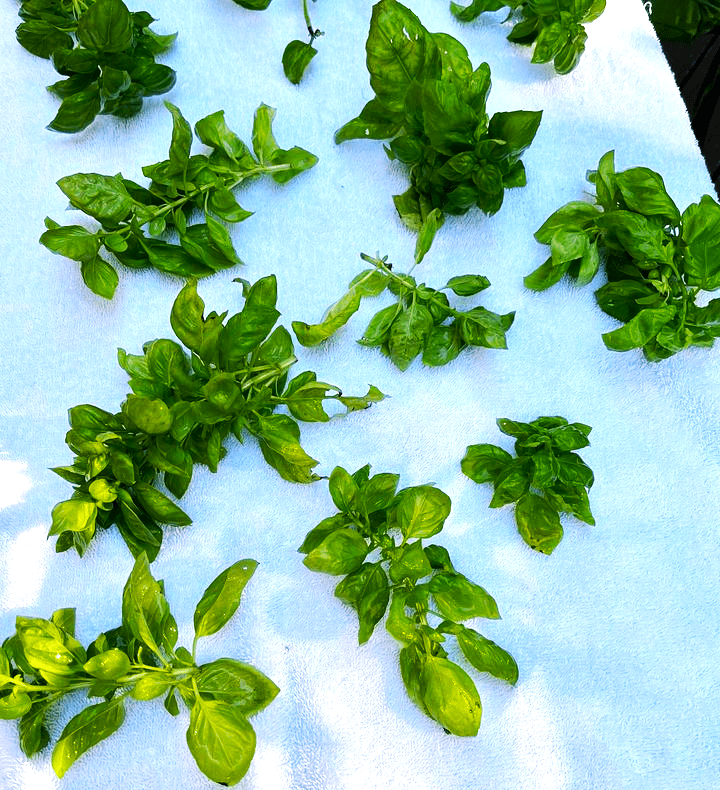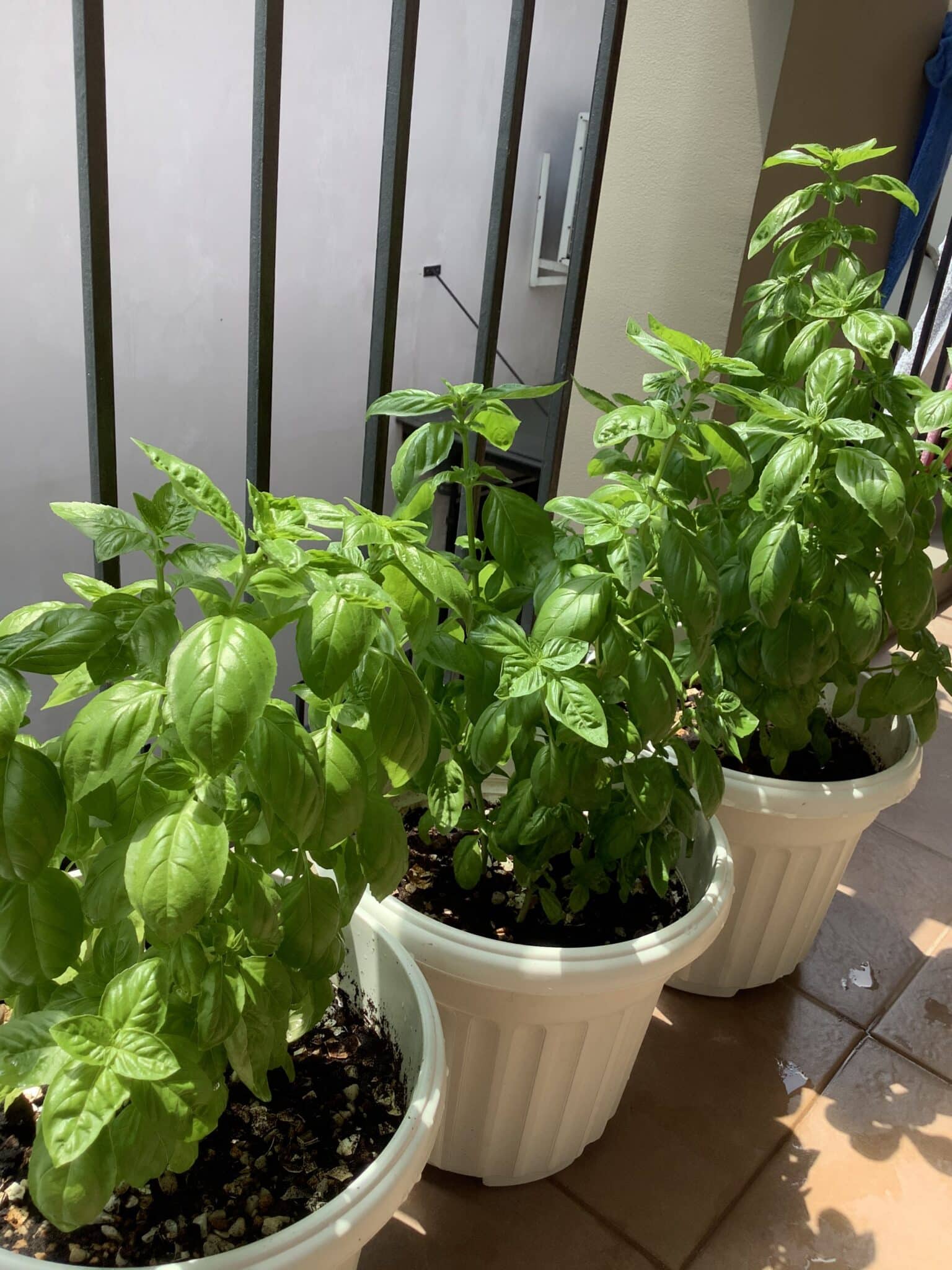Basil plant stays strong and healthy when aided with effective, careful, and regular harvest without the killing intent.
Listen to this article here:
Many unaware growers may empty an entire stem, pick up young leaves, or accidentally cut the leaf nodes, causing the untimely death of their plant.
Thus, read on to learn how to harvest the Basil plant without harming or killing them.
Table of Contents Show
Best Time to Harvest Basil
The right time to pick Basil leaves is essential because picking young leaves may push the plant’s growth back.
A stressed plant is less likely to give new foliage or survive severe weather, causing its untimely demise.
Wait until the plant is mature enough to grow lush foliage. Picking them in spring guarantees juicy leaves and encourages summer growth.
Harvest mature plants as soon as they reach 6 to 8 inches tall. Otherwise, aim for each stem to have around eight pairs of good-sized leaves.
For potted Basil plants, consider picking them around six weeks after planting or when the pot is covered with thick foliage.

Attempting to harvest a few young, nimble leaves will likely empty the stem, causing a lean, uneven growth.
Ensure to harvest early morning, when the dew has set and the leaves are freshest.
Although winter harvesting of leaves is very much possible, consider keeping it to pruning the plant for healthy growth instead of consumption.
If you use Basil leaves around the year, consider drying and storing them for up to six months.
Things to Remember Before Harvesting Basil Leaves
Here are some vital things to remember before harvesting Basil leaves.
1. Wait for the Right Time
- Wait until your plant reaches 6 to 8 inches tall.
- Start harvesting the leaves when the tallest part of the plant has reached 6 inches.
- However, do not let your plant exceed 8 inches before trimming it.
- Use a measuring tape or ruler to determine whether they have reached their mature height.
2. Pay Special Attention to the Leaves
- The healthy leaves look light to mild dark green with 2-3 inches in length.
- But the size of leaves may depend on the Basil variety.
- Prune off the leaves that are yellowing or browning, but avoid using them for consumption.
- Avoid harvesting leaves with severely twisted stems that look wilted or diseased.
How to Harvest Basil Plant Without Killing it?
Unfortunately, the improperly cut Basil will continue to grow tall and leggy.
Here are two basic ways to harvest Basil without killing the plant.
1. Harvesting in Small Quantities
Harvesting Basil for a few leaves is relatively more straightforward.
All you need to do is wait for the foliage to open in spring and pinch off a few healthy-looking leaves from the top.
Pick the Leaves
Pinch off the stalk 1/4 of the inch above the node using your fingers and gently pull away the leaf from the stem.
Also, remember to pick leaves from the different sections of the plant to encourage even growth.
Beware About Cutting the Leaf Node
A damaged leaf node will fail to give new growth and make the stem look emptier.
In addition, the cut wound on the nodes often becomes prey to various plant diseases.
Use a Pruning Tool
Alternatively, you can use a pruning shear or scissor to cut off leaves at the exact axis point to prevent cutting damage.
Use a small pair of scissors, but be careful not to cut the stem.
2. Harvesting in Large Quantities
Harvesting many leaves may be tricky because excessive cutting can adversely affect the plant’s health.
When harvesting a more significant amount, consider the plant’s long-term health.
Use a Top-Down Method
Always harvest Basil plant leaves from the top to down, meaning picking more from the top and less from the bottom.
As per your need, you can use your fingers to pinch or scissors.
Never Empty the Stem
Avoid removing entire leaves from a stem as it encourages lanky stem growth.
Leave at least one-leaf pair at the bottom of a stem when harvesting to encourage further growth.
Alternatively, you can harvest the entire stem by strategically cutting it above the ground, similar to pruning.
Prune your Plant
Ensure to prune the stem 3 inches above the ground and cut 1/4 inches above the stem nodes to encourage the plant to divert nutrients to this stub and away from smaller shoots.
Always prune the outer stems and leave the inner stems as they are to promote a neat-looking plant.
This harvesting practice will remove the outer layer, leaving smaller shoots underneath to receive more sunlight.
Once removed, you can harvest all the leaves from the stem.
How to Harvest Basil to Promote Growth?
A simple trimming may double your Basil harvest by turning single stems into multiple stems.
Regular harvesting of leaves may be helpful for personal use, but it is less likely to help increase the foliage or overall plant.

Harvesting some of the leaves and trimming the stems will encourage bushier growth.
Here are a few ways to prune back the plant for healthier growth.
1. Cut the Overgrowing Stems
- Inspect the plant to locate lanky stems that need cutting.
- Remove just a few stems or cut the plant back by a third to encourage healthier growth.
- Always cut the stem 3 inches above the ground to prevent setbacks.
- Harvest Basil from the top down, cutting off up to half of the total stem length.
2. Trimming Bushier Stems
- Trim stems to reduce thick foliage to let the sunlight reach the inner stems.
- Cut central stems back to a lower set of leaves where two tiny leaf buds emerge from the leaf axil.
- Pinch the central stem back by half and approximately 14 inches above the leaf axils once they are 6-8 inches tall.
- Once you decide where to trim, cut the main stem about a quarter-inch above the leaf buds.
- Cut right above a leaf pair, but do not leave a bare stem section at the top.
- It will keep the plant form dense and more compact.
- Regularly prune the top of stems to discourage your Basil plant from flowering.
How to Store Harvested Basil?
The best thing about the Basil plant is that you can use every bit of the harvest by properly storing it.
The fresh-cut Basil leaves will last up to 6 months when dried and properly stored, but they may only last two days when left in a paper towel.
Here is how you can adequately store Basil leaves.
1. Drying the Basil
Start with picking fresh leaves and give them an excellent rinse under the tap water.
- Leave them on a baking sheet and let them dry slowly in the oven at 35°C (95°F).
- Open and close the oven door several times to let the steam out.
- Alternatively, use an electric air dryer to dry up Basil leaves.
- You can also naturally dry them in an airy, shady place like an attic room.
- But ensure you are not drying any other vegetables alongside it.
- Once dried, you can put them in an airtight Ziploc bag or plastic container and use them for up to a few weeks.
2. Blanche and Freeze the Leaves
Freezing fresh leaves is another effective way to store Basil leaves for a long time.
- Put the freshly cut Basil leaves into a pot of boiling water for five to ten seconds.
- Transfer them to a large bowl with water and ice and keep them still for a few minutes.
- Remove the leaves and lay them flat on a paper towel before storing them in the freezer.
- Otherwise, keep them inside a Ziploc bag before storing them.
3. Make Basil Ice Cubes
Start with harvesting the fresh Basil and thoroughly wash them under tap water.
- Let them dry, and finely cut them into tiny pieces.
- Alternatively, you can process them in a mixture.
- Add them to an ice cube tray with enough olive oil to cover them.
- Freeze them at sub-zero temperatures before transferring them to a freezer bag for prolonged storage.
4. Infuse them into Olive Oil
Fresh Basil leaves in olive oil are another effective way to store and use Basil for meals.
You can drizzle the oil over heirloom tomatoes, pizza, grilled eggplants, and other items.
- Bring saltwater to a boil and blanch Basil leaves for about 5 seconds before adding them to ice water.
- Once cooled, remove the leaves and place them on a paper towel to dry.
- Now, puree Basil with olive oil in a food processor and season with salt and pepper.
- Strain the oil through a mesh and place the filtered solution into a refrigerated jar.
Final Thoughts!
Whether growing Basil for harvest or simply decoration, it is always best to prune back leaves to encourage healthier foliage.
Pruning Basil is a Win-Win! Unlike other houseplants, you can use the pruned Basil leaves for various purposes.
However, properly storing freshly cut leaves is essential to ensure their longevity without losing nutritional value.
